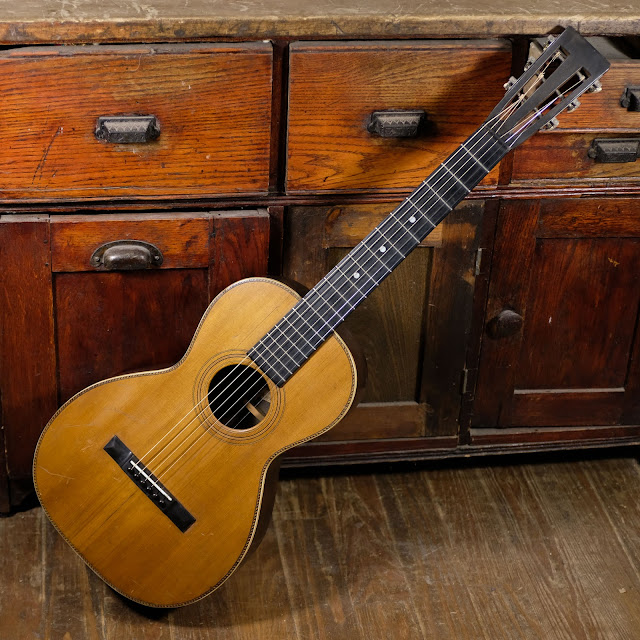1906 Washburn Style 115 Parlor Guitar
Well, I was surprised at what a honey this guitar turned-out to be. It's been hanging-around my workshop for a long time and when I finally got around to taking it apart, I realized that this little gut-stringer is bulked-up in the bracing department a lot compared to the average Washburn from the 1890s. I'm almost certain that many (if not all) of these guitars were made by Regal for this Lyon & Healy brand (most Washburn mandolins were Regal-made, for instance), and this fellow shares Regal's oft-used transverse ladder bracing pattern that I've encountered on 1890s Regal and Washburn products, too.
The difference is that the bracing on this guy's heavier, like Regal's 1920s and 1930s guitars, and with the smaller "size 2" body this one has and its steel-reinforced neck, I figured this would make a much-better extra-light steel stringer than it would a gut/nylon guitar as it was intended when it was built. Normally I would never do such a thing, but this guitar would've been very stiff-sounding with gut/nylon strings. The results speak for themselves -- it sounds hot to trot, full for its size, pretty loud, and it makes a perfect fingerpicking companion.
Work included a neck reset, fret level/dress, bridge replacement (the original was split and uncompensated), cleating and sealing of three top cracks, one back crack cleat and 4 or 5 very minor hairline crack sealing jobs to the back and sides, replacement binding in two small spots, side dots for the neck, replacement tuners (the originals were shot and the "new" ones are 1920s machines), two new bone saddles (one lower for "summer" and one higher for "now/winter"), cleaning, and setup with 46w-10 extra light strings. It plays perfectly with 3/32" EA and 1/16" DGBE action at the 12th fret.
The specs on this are close to a Martin size 2 from the time -- it's 12 1/4" on the lower bout, 3 7/8" deep at the endblock, and it has a short 24 1/4" scale length. The nut is 1 13/16" in width with 1 5/8" spacing of the strings and the bridge has 2 1/4" string spacing. The neck is medium-big in size and has a hard-V shape. There's steel reinforcement in the neck, which Washburn mandolin-family instruments had at the time, too.
The top is solid spruce and the back and sides are solid, Brazilian rosewood. The board and bridge (and the original bridge) are both ebony and this has an ebony headstock veneer, too. The top edge has "half-herringbone" purfling and there's cream celluloid binding on the top and back edges as well.
When this guitar was made, Washburn's reputation as a brand was comparable to Gibson or Martin, and the workmanship on the instruments is quite good.
The nut is ebony and don't you love that blocky, precisely-cut headstock shape?
The board has pearl-dot markers and fresh white side dots.
There's a minor hairline crack in the fretboard extension and the extension itself tilts down away from the main fretboard ever-so-slightly over the body.
As far as the three top cracks -- there's one here next to the fretboard extension on the bass side, one below the soundhole (it's the center seam), and one below the bridge extending to the endblock. All are cleated and sealed and good to go.
The old bridge looked almost the same -- it was a flattened pyramid type and a little narrower. This replacement one has rounded-off pyramid wings akin to a Bay State/Haynes guitar. The bridge pins are new, ebony ones.
The discoloration on the side next to the heel isn't from the neck reset work -- it was there when this came in.
The bone or ivory endpin is original.
Here's the Washburn label. The serial number is also stamped at the neckblock and, per the Washburn Pre-War book, seems to indicate 1906 manufacture. That'd make sense for the ongoing design changes from that period of the company's history.





















Comments
All the best from Oz
Alex
Jake, I'm not sure where you come up with this idea, Pleijsier in his Washburn book clearly states that Regal took over production of Washburn-branded instruments in May of 1930 after L&H sold all its manufacturing.
I've worked on a lot of early Washburns and they're very well made with quality materials .. a cut higher than what I've seen in typical Regals, even the early ones. And Washburn had a huge factory to handle its production.
Can you name any sources for your above claim? I don't tend to agree with you based on the research out there. Just trying to clarify ...
Thx..Tom
I recently pulled a Washburn style 115 out of my folk's attic. The D string tuner skips once it gets to a certain tension. A reputable local guitar shop said that they are unable to be repaired, as they are forged. The whole E-A-G part unit will need to be replaced. I'm looking for a replacement. Do you have any idea if there is a place that "parts out" these instruments?
Thanks,
Wil